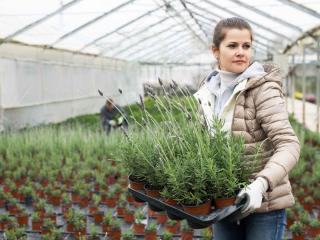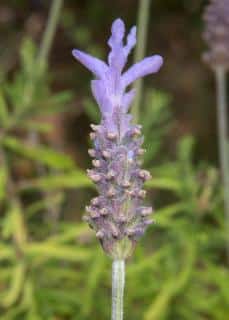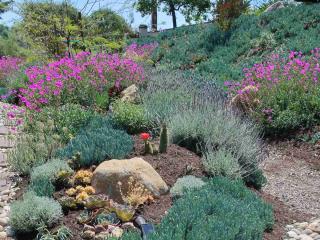

Lavandula dentata is a wonderful ornamental shrub.
List of Lavandula dentata facts
Name – Lavandula dentata
Common – French, toothed, fringed
Family – Lamiaceae
Type – small shrub, herbaceous
Height – 24 to 40 inches (0.6 to 1 m)
Exposure – dry full sun
Soil: any, very drained – Foliage: evergreen – Flowering: early → mid-summer
Often called French lavender, especially in the United States, it boasts all the great assets of common lavender with the added benefit of showy flowers and cute toothy leaves.
Read also:
Most important is to ensure perfect drainage, so that roots stay out of sitting water.
The ideal season is to plant in fall. This gives the end of the season for the plant to settle in before the winter. The best soil for this plant is well-draining, neutral/alkaline soil.
 Set the clump in a pail of water while you dig a hole that is three times as wide as the clump.
Set the clump in a pail of water while you dig a hole that is three times as wide as the clump.This plant can bear the brunt of hot sunrays in stride. It actually makes the plant more fragrant!
To emphasize this, place it in the hottest, driest, sunniest spot of your garden!
The key to helping your L. dentata thrive is to control moisture: aim for none!
Pots require much more attention than L. dentata growing in the ground (to be honest, when in the ground, watering is never needed).
In pots and containers, however, it’s important to check on moisture often. That way you’ll get a hang of when the plant needs water, and only water then.
Very vulnerable to the cold in year 1, fringed lavender is a bit hardier as it grows older.
In the ground, there is no need to add fertilizer.
In pots, apply any flower-specific fertilizer (low dosage) or prepare fertilizer yourself from weeds.
Lavender does not grow back from old wood. Cutting it to the stump would usually kill it. Lavandula dentata, in particular, is very delicate in this respect.
 If time is short, the following yearly pruning is quick and effective. Simply take care not to cut too deeply into old wood.
If time is short, the following yearly pruning is quick and effective. Simply take care not to cut too deeply into old wood.
>> Pruning L. dentata, a two-minute video <<
Much of the joy of growing L. dentata comes from the long-lasting scent the flowers have. This can be harnessed to make replacement scented softener for clothes!
For more fragrance, you can also make lavandula wands. These, unlike the grain-filled pouches, are best made from newly opened flowers. Since the ribbons and stems form a loose basket in this project, it’s best when the grains stay firmly attached to the stem.
Pest-resistant and virtually disease-resistant, too.
Only cause for concern: root rot due to whichever root rot fungus is dormant in the ground: Rhizoctonia, Phytophthora, Thielaviopsis or Pythium.
Symptoms
Cure
When caught early on, it may still be possible to save the plant.
This wonderful plant brings together two wonderful joys: amazing fragrant flowers and cute, tooth-edged leafage.
 It also goes by the name “Butterfly lavender”, mostly because it attracts them but also because of the winged appearance of the flower. It shares this fluttery common name with Lavandula stoechas.
It also goes by the name “Butterfly lavender”, mostly because it attracts them but also because of the winged appearance of the flower. It shares this fluttery common name with Lavandula stoechas.
Just like other types of lavender, Lavandula dentata was, and still is, extensively used for perfume, cosmetics and hygiene products.
Its pungent compounds also help repel aphids. They are a welcome addition near tall-growing English roses!
Somewhat uncannily, L. dentata is called “Lavande anglaise” (English lavender) by the French, but “French lavender” by the English and the rest of the world!
After pruning your plant, grow cuttings from trimmings in small terra cotta pots. They will grow and make perfect gifts for family, friends and neighbors!
I do not think that specific pruning works on this type of lavender. I normally cut the dead flowers away little by little and my lavender has been with me for over 5 years; It is really big and healthy. My mother pruned it like that from one side and that side never did grow back. The plant is really particular to how it is handled.
Hi Yesenia, that’s a good insight. I tried to stress in the article how important it is to remain within the leafy green portion of the plant. As you say, the plant doesn’t like being pruned back too severely. The best care is really what you’re doing, simply snipping a stem back after it bloomed, one by one. Yours must look absolutely beautiful!